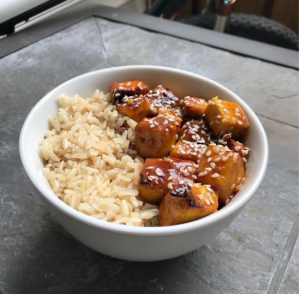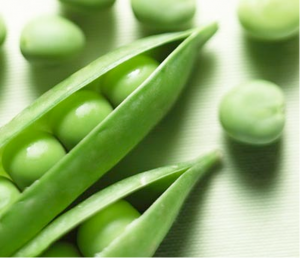
Where Do You Get Your Protein? A Helpful Guide To Plant-Based Protein Options
— By Alex Bosse, Nutrition Education Professional, University of Maine Cooperative Extension
Are you curious about incorporating more plant-based foods into your diet but worried about not getting enough protein throughout the day? There are plenty of healthy, affordable, sustainable, and delicious plant-based protein options. Whether it’s plant-based protein options such as tofu, tempeh, seitan, legumes, nuts, seeds, or quinoa, there are plenty of plant-based protein options that will satisfy your taste cravings.
Protein In Plant-Based Foods
When talking about protein, it is important to know how much protein you should be getting throughout the day. MyPlate is a great guide, as it gives daily recommendations for each food group. While protein needs vary based on sex, age, height, weight, and physical activity, it is recommended that adults get anywhere between 5-7 ounces of protein each day. An ounce-equivalent of plant-based protein can include anything from 1/4 cup cooked beans, 1 tablespoon of peanut butter, 1/2 ounce of nuts or seeds, 1/4 cup tofu, 1 ounce cooked tempeh, or 2 tablespoons hummus. More details can be found on USDA’s MyPlate website.
Whether you’re trying to reduce your meat intake in your diet or interested in becoming vegetarian or vegan, there are plenty of plant-based protein options that are discussed more in detail below.
Learn more about:
Seitan
Tempeh
Tofu
Pea & Soy Protein
Seitan

- What is it? Seitan is a protein-packed meat substitute made from wheat gluten. With a chewy texture and savory flavor, it is often compared to foods such as chicken and portobello mushrooms. It often takes on the flavor of most sauces and marinades that it is cooked in, and it is perfect as a meat substitute.
- Nutrition information: It is best to include seitan with other protein sources throughout the day like beans or quinoa for example because it is an incomplete protein. Seitan is also high in the minerals selenium (which plays an important role in immune health) and iron (which helps make hemoglobin, an important part of red blood cells).
- Ways to cook it: While seitan is more difficult to find pre-packaged, you can prepare it at home from many useful resources and recipes found online. Seitan is prepared by combining wheat flour and water. The water activates the gluten in the wheat flour, and once the gluten is activated and the starch is removed, it forms an elastic chewy texture that can be incorporated into a plethora of dishes or recipes including homemade seitan wings, burritos, hot dogs, kebabs, curry dishes, Chinese dishes, and more.
Tempeh

- What is it? Tempeh is a fermented soy product originating from southeast Asia that comes in a block shape. It is much more firm than tofu, and has a more nutty and savory taste, and like seitan, it often takes on the flavor of most sauces and marinades that it is cooked in, and it is perfect as a meat substitute.
- Nutrition information: Like seitan, tempeh is a high-protein food, and it is one of the few plant-based options that is a “complete” protein. Tempeh is also high in iron, fiber, and it is a great dairy-free source of calcium. Other nutrients that are found in higher amounts in tempeh include riboflavin, magnesium, manganese, and phosphorus.
- Ways to cook it: With origins in southeast Asia, tempeh can commonly be found in many dishes including stir-fries, fried rice dishes, satays, and curry dishes. Since it is so versatile and has grown significantly more popular in recent years, it is often marinated and put into dishes such as salads, tacos, burritos, and sandwiches (such as reubens, BLT’s, and sloppy joes).
Tofu

- What is it? Tofu is a soy-based product that is made by condensing soy milk into solid blocks. Like tempeh, tofu is used in many Asian dishes and takes on the flavor of whatever it is marinated in. You can find many different types of tofu sold in stores depending on its firmness and water content.
- Nutrition information: Tofu is a high-protein food and is one of the few plant-based options that is a “complete” protein. Tofu is also an excellent source of calcium and iron.
- Ways to cook it: Tofu can be found in most grocery stores and is prepared in many different ways. Before cooking with tofu it is important to make sure that you drain and press your tofu with a paper towel or a tofu press for 30 minutes or longer. Once pressed, it is ready to be used for cooking in many tasty dishes including stir fries, chilis, veggie burgers, tacos, and much more. Refer to the two delicious tofu recipes below:
Pea Protein & Soy Protein

- What is it? Plant-based burgers such as the Impossible Burger and the Beyond Burger are all the craze these days. You can find them in most grocery stores, and they are offered at many commercial restaurants and fast-food chains nowadays, but what is in them and are they healthy? Unlike most veggie burgers (which contain mostly whole vegetables), these burgers are made up of mostly protein extracts from various plants including soybeans and peas. To better mimic the look, taste, and cookability of beef, many of these burgers have ingredients such as soy leghemoglobin and beet juice extract added to them to mimic the bleeding characteristic of beef.
- Nutrition information: While there are many benefits to these plant-based burgers (no cholesterol, a source of complete protein, and more vitamins and minerals), it is still important to consider that these burgers are still processed foods that are high in sodium and saturated fat, which can lead to higher blood pressure and an increased risk for heart disease. While these burgers may be a great stepping stone for those looking to become vegetarian or vegan, moderation is key, and it is important to eat more whole vegetables throughout the day.
So whether you’re looking to cut down on your consumption of meat, enjoy a Meatless Monday with the family, cut out meat or even all animal products from your diet, a plant-based diet is a healthy option. For more information, check out the resources below for more tips to go vegetarian.
Resources
- The U.S. Department of Health and Human Services and the U.S. Department of Agriculture. (2020, December). 2020-2025 Dietary Guidelines for Americans. 9th Edition.
- United States Department of Agriculture. “Protein Foods” USDA.
- United States Department of Agriculture. “Tofu with Broccoli” USDA.
- University of Maine Cooperative Extension Expanded Food and Nutrition Education Program (EFNEP) “Mainely Dish” Recipe Video Series. “Stir Fry Vegetables with Chicken, Beef, or Tofu” YouTube, uploaded by The University of Maine, 11 January 2021.
